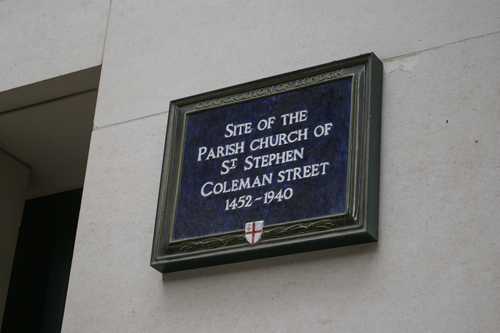The church of St Stephen Coleman Street is where John Keats’ parents and maternal grandparents, and his younger brother Tom, were buried. There is now nothing left but a blue plaque.

The Keats Connection
It makes for sad reading! Keats lost all his most significant figures from the previous generations in the space of just over ten years, beginning with his father when John Keats was only nine years old. However, St Stephen’s was also associated with a few more positive occasions.
- His grandfather John Jennings was baptised here on 13 October 1730.
- His maternal grandparents John Jennings (age 43 years) and Alice Whalley (age 38 years) married here on 25 February 1774.
- His father Thomas Keats died on 15 April 1804, and was buried at St Stephen’s on 23 April 1804.
- His grandfather John Jennings died less than a year later on 8 March 1805, and was buried at St Stephen’s on 14 March 1805.
- His mother Frances Jennings Keats Rawlings died five years later, and was buried here on 20 March 1810.
- His grandmother Alice Whalley Jennings died four years later, and was buried here on 19 December 1814.
- Finally, his brother Thomas Keats died, and was buried here four years later on 7 December 1818.
The burials were all in the Jennings family vault.
The church itself was destroyed in 1940. I know it sounds a little ghoulish, but I wanted to know what happened to the bodies … and I discovered they were relocated to Brookwood Cemetery in Woking, Surrey. Follow the link for a separate post about that!
Back Then
St Stephen’s was first mentioned in the 13th century.
It became a “Puritan stronghold” for a while in the 17th century. The playwright and contemporary of Shakespeare, Anthony Munday, was buried there in 1633.
The medieval church was destroyed in the Great Fire in 1666. It was re-built by Christopher Wren, with the exterior completed by 1677. Further work on a gallery and burial vault was done in the 1690s. This is the church that the Keats family would have known.
The church was destroyed by incendiary bombing on 29 December 1940, and it was not re-built.
The parish was combined with that of nearby St Margaret Lothbury – which for various reasons accumulated a number of City parishes, and is now officially known as “St Margaret Lothbury and St Stephen Coleman St with St Christopher-le-Stocks, St Bartholomew-by-the-Exchange, St Olave Old Jewry, St Martin Pomeroy, St Mildred Poultry and St Mary Colechurch”.

Today
Modern office buildings now stand on the site, with retail shops and cafes at ground level. A London Corporation plaque commemorates the church. It reads:
Site of the Parish church of St Stephen Coleman street 1452-1940
You can find it nearly opposite the junction of Coleman Street with King’s Arms Yard, outside Black Sheep Coffee.
Details
- Address: 35 Coleman Street, London EC2R 5EH
- Tube: Moorgate, on the Northern line, and the Circle, Hammersmith & City, and Metropolitan lines
- Bank, on the Central, DLR, Northern, and Waterloo & City lines
- Opening hours: The blue plaque can be seen at any time, though the area is probably ghostly quiet on weekends
Links
- St Stephen Coleman Street page on London Remembers website
- St Stephen Coleman Street page on Wikipedia
- St Mary Lothbury website

